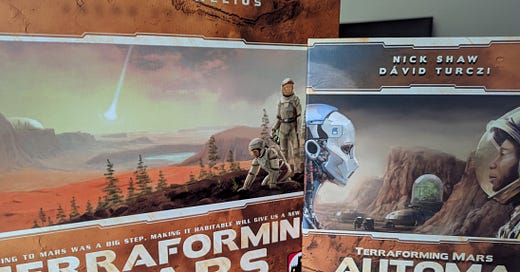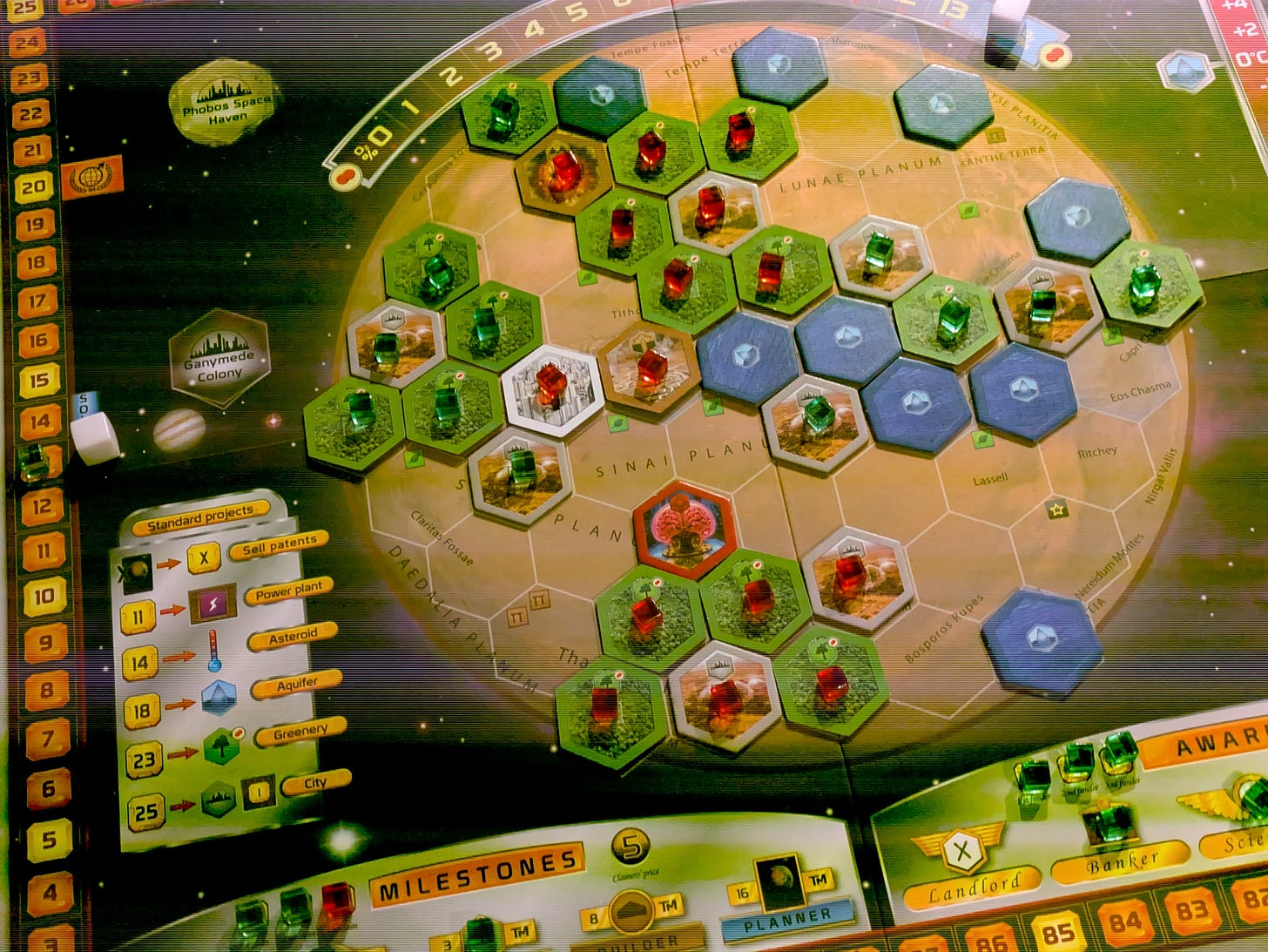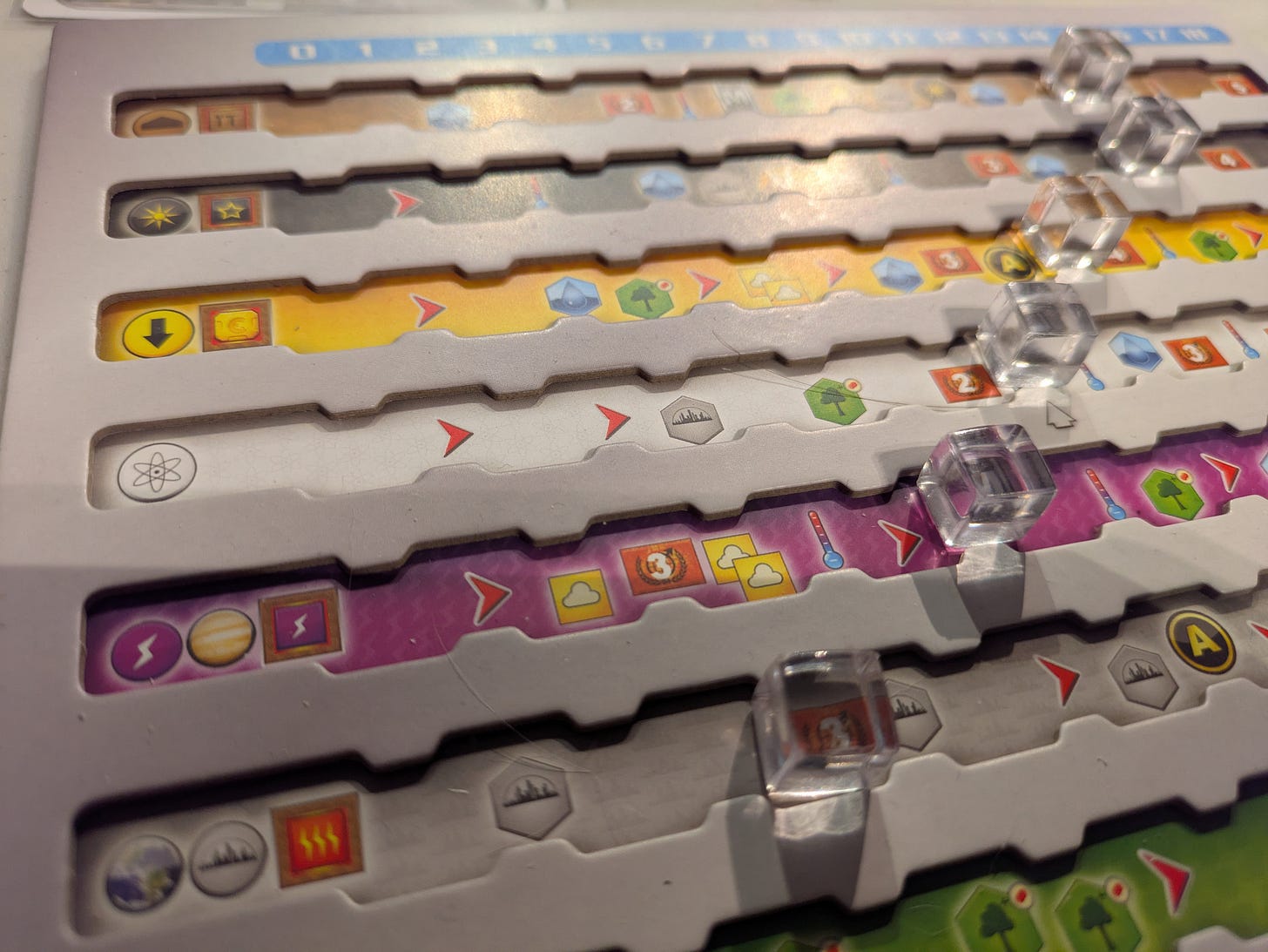Terraforming Mars: Automa Playthrough
Strategies and insights from my playthrough, highlighting the exciting challenges that the Automa brings to the game.
Let’s be real—turning the Red Planet into a habitable world is no small feat. It takes strategic decisions and plenty of effort. The Automa solo mode pits you against Marsbot, challenging you to outmatch its efficiency. Think you can terraform Mars better than an AI? In this article, we’ll see who truly comes out on top!
I went with the United Nations Mars Initiative to face off against Marsbot’s Tycho Magnetics. This corporation has a compelling ability—whenever I increase my Terraforming Rating during a generation, I can pay 3M to boost it even further. This makes it easier to stay competitive with Marsbot by keeping my TR within reach.
Setup for Marsbot's corporation sets an Interface Hyperlink bonus card (shown below) that must be placed at the bottom of the Marsbot’s draw pile. However, once drawn, they will advance on multiple tracks based on the number of cards drawn. This is where they can accumulate a substantial number of actions on their advancement tracks.
Marsbot always tends to be strong in two key areas: Terraforming Rating and constructing numerous cities and greenery tiles. They make you fight for every victory point in the race to terraform Mars. I nearly defeated a few times, but they edged me out by the slimmest margin!
Marsbot is highly aggressive when it comes to claiming milestones and awards. While you can compete and reach for awards throughout the game, milestones are a different story—once Marsbot claims them, they’re gone for good.
For the human player, securing milestones can be challenging since Marsbot advances the tracks much faster. Achieving the three-city milestone within four or five generations is especially tough unless you use the standard project action and pay 25M. However, doing so often means sacrificing valuable cards you could have played instead.
The same applies to greenery tiles. In hindsight, I would prioritize them more, as they rapidly increase your Terraforming Rating, boosting your mega credit income during the production phase. Later in the game, as you accumulate resources, strategically placing cities next to your greenery tiles can help maximize your victory points.
Strategies On Planning Ahead
At the start of the game, I purchased six intriguing cards, one of which was a recurring action card that granted 2 greenery resources whenever an ocean tile was placed.
I also had to watch out for Marsbot stealing five planetary resources, as it has a bonus card that removes five of your greenery resources. If you start accumulating these, be sure to convert them into a greenery tile as soon as possible—otherwise, Marsbot will snatch them away.
When choosing cards, I prioritize those that boost resource production—whether it’s energy, heat, plants, mega credits, or titanium—since they provide long-term benefits. I also look for specific tags that create strong synergies or cards that generate victory points by the end of the game.
Microbe and animal cards can be valuable as well, allowing you to accumulate resources on them for additional victory points.
A challenge I often face is acquiring cards that can only be played once specific conditions are met, requiring careful planning and long-term investment.
Meanwhile, Marsbot steadily pushes forward, terraforming Mars at a relentless pace. That’s why I also prioritize cards that offer immediate value early in the game.
Milestones & Awards
By the 5 or 6th generation, Marsbot secured two milestones: City and Gardener. Meanwhile, my corporation had the advantage of using the special action to increase my Terraforming Rating, which eventually allowed me to claim the Terraformer milestone. Even that was a close race, as Marsbot was just on the verge of claiming it.
Securing milestones and awards is essential to keeping up with Marsbot—if you ignore them, they’ll claim them all and potentially rack up around 30 VP. I’ve had games where I overlooked milestones, and it really hurt my final score.
I actually enjoy having milestones and awards in the game since they provide clear goals and easy ways to earn extra points.
However, as I mentioned earlier, Marsbot is extremely aggressive in claiming them. It can be frustrating when they push ahead in certain actions, snagging greenery and city tiles before you get the chance.
Cities & Greenery Tiles
Some people in Facebook groups suggest not prioritizing city or greenery tiles—wrong! I always make them a key focus, especially on the Tharsis map. As I mentioned, Marsbot is highly aggressive and can quickly build cities around your greenery, stealing valuable VP.
On the Tharsis map, Marsbot’s strength lies in city and greenery placement, as there are key milestones and awards tied to them. For example, the Landlord award rewards the player with the most city and greenery tiles.
I’m not too obsessed with cards—don’t get me wrong, I play them, but my excitement (and frustration) comes more from the tile-placement battle.
Maybe I should try a game where I focus solely on standard projects—just build, build, and build!
End of Game
Final score of the game:
Tycho Magnetics (Green Cude): 113pts
United Nations Mars Initiative (Red Cube): 88pts
Mars was fully terraformed by the 13th generation. As expected, Marsbot defeated me once again, this time by 24 points. In the end, they proved to be the smarter ones, successfully transforming the Red Planet.
One aspect of Terraforming Mars that I’m not too fond of are the cards, especially later in the game when many end up being discarded because they don’t provide much value. By that point, you’ve usually accumulated so many mega credits that it’s more efficient to rely on standard projects to complete the terraforming process and gain TM.
Advantages During Gameplay
I lost a lot of ground early on as Marsbot quickly advanced with city and greenery tiles. Which, they wasted no time claiming the City and Gardener milestones, but eventually, I still managed to secure the Terraformer milestone.
I did generate a lot of heat resources but wasn’t able to claim the Terminal award as the Marsbot swept up all the other awards.
Eventually I did catch up with city and greenery tiles which I managed to squeeze some valuable points.
Drawbacks During Gameplay
Marsbot claimed most of the milestones and awards, leaving me with only the Terraformer milestone. I tried to compete for the awards, but I just wasn’t drawing the right cards to secure them.
I usually aim to finish the game by the 12th generation but instead finished at the 13th generation. As the game progresses, after the 12th generation, Marsbot begins accumulates more VP based on the amount of mega credits they collect. With each passing generation, the point gap can grow more an more.
Key Strategies To Remember
Scaling VP Generation: As the game progresses, cities and greenery naturally lead to compounding VP gains.
Consistent TR Growth: Focusing on TM ensures a steady increase in VP throughout the game.
Control Over Board Positioning: By dominating city placement, Marsbot can restrict opponent expansion.
Milestones & Awards: Cities/Greenery often align with Gardener, Mayor, or Landlord milestones/awards, giving additional scoring potential.
Generations: Quickly Terraform Mars within a certain amount of generations.
Conclusion
Every game is always a struggle against the Marsbot which I’m not particularly skilled at this game. While there are numerous strategies to outplay Marsbot, I often come up short. My approach is to use these strategies above to follow a familiar pattern, though it also hinges on the cards I happen to draw.
As a solo player, investing in the Automa expansion was a great decision—it really helped me learn the ins and outs of the game.
If you’ve played with the Automa, share your strategies in the comments! And if you’ve managed to defeat the Marsbot, be proud of it and don’t hold back—humans should be beating these machines!









